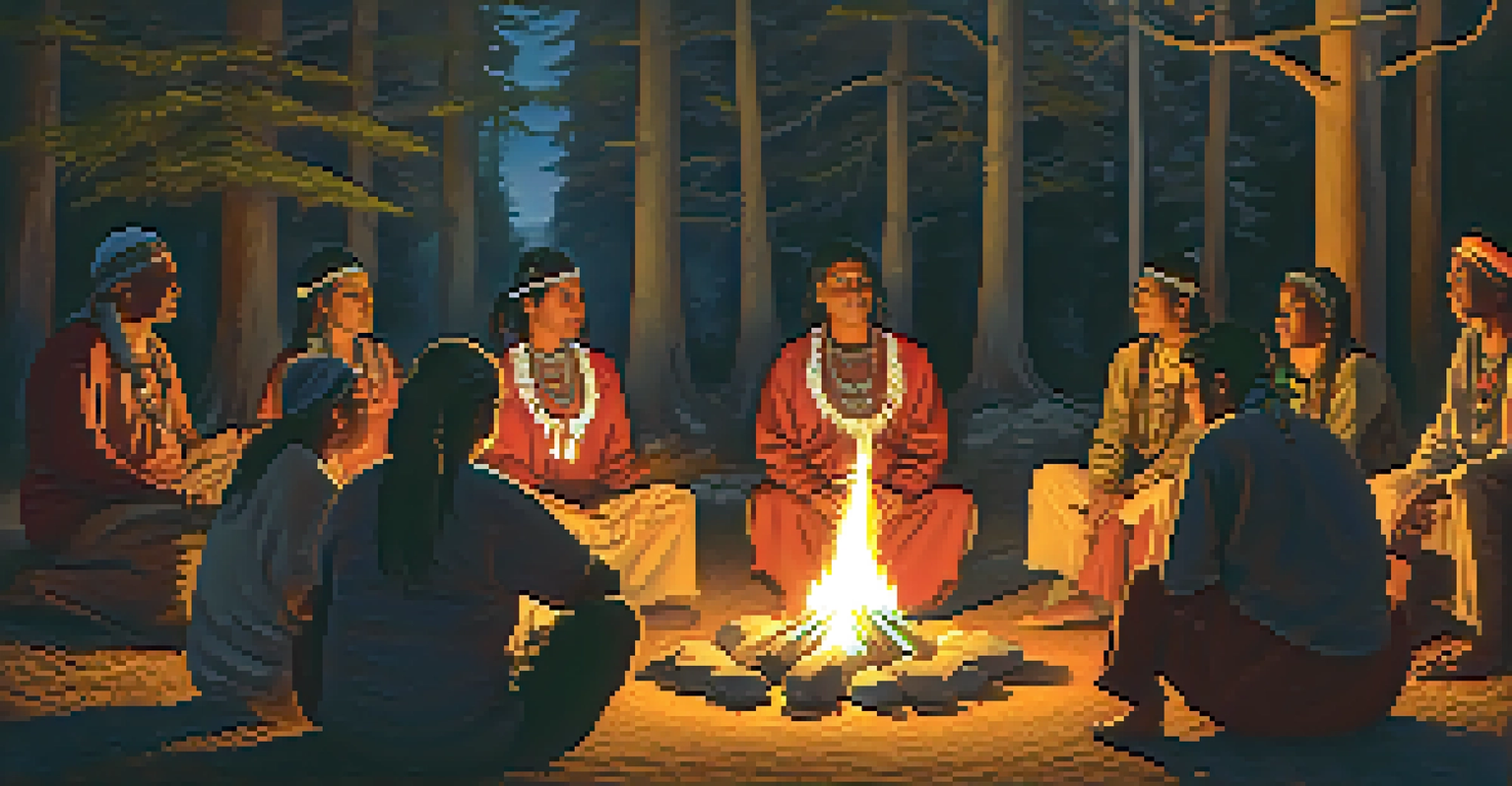The Intersection of Peyote Use and Indigenous Healing Practices

Understanding Peyote: A Sacred Cactus
Peyote, a small cactus native to Mexico and the southwestern United States, has been used for centuries by Indigenous peoples for its psychoactive properties. This cactus contains mescaline, a compound that induces altered states of consciousness, often sought for spiritual insights and healing. While peyote is often associated with recreational use today, its significance runs much deeper within various Indigenous cultures.
Nature is not a place to visit. It is home.
For many tribes, peyote is not just a plant but a sacred entity that connects them to their ancestors and the spiritual world. It plays a vital role in traditional ceremonies, particularly in the Native American Church, where it is used as a sacrament to facilitate communion with the divine. The healing properties attributed to peyote extend beyond the physical, encompassing emotional and spiritual dimensions.
Incorporating peyote into healing practices underscores the interconnectedness of body, mind, and spirit. By understanding peyote’s cultural significance, we can appreciate its role in holistic healing and the broader context of Indigenous traditions.
Indigenous Healing Practices: A Holistic Approach
Indigenous healing practices often focus on treating the whole person—body, mind, and spirit—rather than just addressing specific ailments. This holistic approach stems from a deep understanding of the interconnectedness of all life forms and the influence of the environment on health. Traditional healers, or medicine people, utilize various methods, including herbal remedies, rituals, and spiritual guidance.

These practices are deeply rooted in the cultural beliefs and values of each community, emphasizing the importance of relationships and community support in the healing process. For example, storytelling and music play crucial roles in healing ceremonies, reinforcing cultural identity and fostering emotional resilience. This sense of belonging and connection helps individuals navigate their challenges more effectively.
Peyote's Cultural Significance
Peyote is a sacred cactus integral to Indigenous healing practices, serving as a tool for spiritual connection and community bonding.
The integration of peyote into these healing practices enhances the spiritual aspect, allowing individuals to explore their inner selves and gain insights into their life journeys. It’s a reminder that healing is often a communal experience, where shared wisdom and traditions contribute to individual well-being.
The Role of Ceremony in Peyote Use
Ceremony is a fundamental aspect of Indigenous culture, and the use of peyote is often embedded within these sacred rituals. These ceremonies are typically conducted in a group setting, where participants gather to share experiences, prayers, and songs. This collective approach fosters a sense of unity and shared purpose, enhancing the healing process.
Healing is a matter of time, but it is sometimes also a matter of opportunity.
During a peyote ceremony, participants consume the cactus in a controlled and respectful manner, guided by a knowledgeable leader. The experience is viewed as a spiritual journey, allowing individuals to confront personal challenges and seek guidance from higher realms. Participants often report profound insights and emotional releases during these ceremonies, which can lead to lasting transformations.
Moreover, the ceremonial aspect of peyote use emphasizes respect for nature and the spiritual world. It serves as a reminder of the sacredness of life and the importance of community, reinforcing the values that underpin Indigenous healing practices.
Modern Context: Challenges and Opportunities
In recent years, there has been a resurgence of interest in peyote, both within Indigenous communities and among outsiders seeking spiritual experiences. However, this increased demand raises concerns about sustainability and cultural appropriation. As the habitat for peyote diminishes due to overharvesting and climate change, protecting this sacred plant becomes increasingly urgent.
Indigenous leaders advocate for the preservation of peyote and its cultural significance, emphasizing that it should be used respectfully and within the context of tradition. They highlight the need for education about the proper use of peyote, ensuring that those who seek it understand its profound spiritual and cultural implications. This educational approach helps bridge the gap between Indigenous and non-Indigenous perspectives.
Holistic Healing Practices
Indigenous healing emphasizes treating the whole person—body, mind, and spirit—through communal support and traditional methods.
Ultimately, the challenge lies in balancing the growing interest in peyote with the need to respect and preserve Indigenous traditions. By fostering dialogue and understanding, we can create opportunities for collaboration that honor the wisdom of Native cultures while addressing contemporary concerns.
The Health Benefits of Peyote in Healing
Research into the health benefits of peyote is still in its early stages, but preliminary studies suggest that its psychoactive properties may aid in treating various mental health issues. For example, some users report reductions in anxiety, depression, and PTSD symptoms after participating in peyote ceremonies. These experiences point to the potential of peyote as a complementary approach to mental health treatment.
The insights gained during peyote journeys can lead to greater self-awareness and emotional healing, allowing individuals to confront past traumas and make positive changes in their lives. This transformative potential is a key reason why many seek out peyote within Indigenous healing contexts. It highlights the importance of integrating psychological and spiritual healing.
However, it’s essential to approach the use of peyote with caution and respect, given its powerful effects. Engaging in this practice under the guidance of experienced Indigenous healers ensures that individuals are supported throughout their journey, maximizing the benefits while minimizing risks.
Respecting Indigenous Knowledge and Practices
As interest in peyote and Indigenous healing practices grows, it's crucial to approach these topics with respect and sensitivity. Indigenous knowledge is often rooted in centuries of experience and cultural heritage, and it’s vital to honor that wisdom. This means recognizing the authority of Indigenous communities in matters related to their traditions and practices.
Cultural appropriation is a significant concern, as outsiders may attempt to adopt Indigenous practices without understanding their context or significance. This not only disrespects the traditions but can also dilute their meaning and effectiveness. Engaging with Indigenous communities respectfully and seeking permission to learn or participate is essential in fostering positive relationships.
Sustainability and Respect Needed
The growing interest in peyote raises concerns about cultural appropriation and sustainability, highlighting the need for respectful engagement with Indigenous traditions.
By prioritizing respect for Indigenous knowledge, we can create a more inclusive dialogue that values cultural diversity. This approach enriches our understanding of healing practices and promotes a more equitable exchange of ideas between cultures.
The Future of Peyote and Indigenous Healing
Looking ahead, the future of peyote and Indigenous healing practices will likely be shaped by ongoing discussions about sustainability, cultural preservation, and mental health research. As more people recognize the value of traditional healing methods, there’s an opportunity to create greater awareness and appreciation for Indigenous perspectives on health and wellness.
Collaborative efforts between Indigenous and non-Indigenous communities may lead to innovative approaches that honor traditional practices while addressing contemporary needs. This can include research partnerships that respect Indigenous methodologies and prioritize cultural integrity. Such collaborations can provide valuable insights into the efficacy of peyote and other traditional healing practices.

Ultimately, the future of peyote and Indigenous healing lies in mutual respect and understanding. By acknowledging the wisdom of Indigenous cultures and working together, we can foster a more holistic approach to healing that benefits everyone.